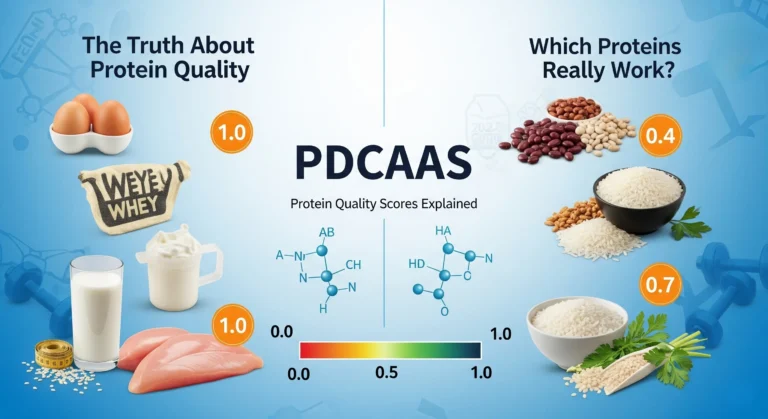
Searching for protein options for lactose intolerant athletes can feel like navigating a minefield! Did you know that nearly 65% of adults worldwide experience some form of lactose intolerance? That’s a staggering number, and it includes countless athletes who’ve been struggling to find the right protein sources to fuel their training.
If you’re one of those athletes who gets bloated, gassy, or uncomfortable after your usual whey protein shake, you’re definitely not alone. I’ve been there myself – nothing ruins a good workout like spending the next hour dealing with stomach cramps and digestive issues.
The good news? Finding quality protein options for lactose intolerant individuals doesn’t mean you have to compromise on your gains or performance. In fact, there are plenty of incredible alternatives that might actually work better for your body than traditional dairy-based supplements. Let’s dive into the best protein options for lactose intolerant athletes and everything you need to know about making the switch!
Understanding Lactose Intolerance in Athletes
Let me tell you, I learned about lactose intolerance the hard way. For months, I couldn’t figure out why I felt terrible after every post-workout shake. I’d down my whey protein, feel great for about 20 minutes, then spend the next hour dealing with bloating and stomach issues that made me want to skip my next workout entirely.
Lactose intolerance happens when your body doesn’t produce enough lactase, the enzyme that breaks down lactose (milk sugar). What’s really interesting is that most humans actually lose the ability to produce lactase as they age – it’s totally normal! Some people just lose it faster or more completely than others.
For athletes, this creates a unique problem. We need more protein than the average person, but the most popular and convenient protein sources are dairy-based. I’ve seen so many training partners struggle with this exact issue, thinking they just had “sensitive stomachs” when really they were lactose intolerant.
The symptoms can be brutal during training. We’re talking about bloating that makes you feel like you swallowed a basketball, gas that clears out the gym, and digestive issues that can last for hours. Some athletes even experience fatigue and brain fog, which definitely doesn’t help when you’re trying to push through a tough workout.
Here’s what really frustrated me when I was figuring this out – lactose intolerance isn’t the same as a milk protein allergy. With lactose intolerance, it’s just the sugar in dairy that’s the problem. Milk protein allergies are completely different and involve your immune system reacting to the actual proteins in milk. Understanding this difference was huge for me because it meant I had way more options than I originally thought.
Plant-Based Protein Powders: The Game Changers
Okay, I’ll be honest – when I first heard about plant-based protein powders, I was skeptical. I had this mental image of chalky, terrible-tasting powders that wouldn’t give me the results I wanted. Boy, was I wrong!
Pea protein completely changed my game. The first time I tried it, I was shocked at how smooth it mixed and how good it tasted. But more importantly, I felt amazing after drinking it – no bloating, no digestive issues, just clean energy. Pea protein is considered a complete protein, meaning it has all the essential amino acids your body needs. The leucine content is particularly impressive, which is crucial for muscle protein synthesis.
Hemp protein was another revelation, though I’ll admit it took some getting used to. The first brand I tried had this earthy, almost nutty flavor that wasn’t bad, just different. What I love about hemp protein is that it comes with omega fatty acids and fiber – stuff you definitely don’t get from whey. It’s not as high in protein per serving as some other options, but the additional nutrients make it worth considering.
Rice protein surprised me the most. I expected it to be bland and useless, but it’s actually really well-absorbed and hypoallergenic. I started mixing it with pea protein after reading that they complement each other’s amino acid profiles perfectly. Game changer!
Now, let’s talk about soy protein for a second. There’s so much fear-mongering around soy, especially for male athletes. I did my research, talked to sports nutritionists, and tried it myself. The truth? For most people, soy protein is perfectly fine and actually has some unique benefits. The isoflavones in soy might even help with recovery, though I know some people prefer to avoid it just to be safe.
The real magic happens when you use multi-blend plant proteins. These combine different plant protein sources to create a more complete amino acid profile than any single plant protein alone. I’ve been using blends for over two years now, and my recovery and muscle gains have been just as good as when I was using whey, if not better.
Dairy-Free Animal Protein Sources
If you’re not ready to go full plant-based, don’t worry – there are some fantastic animal protein options that are completely lactose-free. I actually rotate between plant and animal proteins depending on my training phase and how I’m feeling.
Egg white protein powder was my first successful switch away from whey. It mixes incredibly well, has zero lactose, and provides all the essential amino acids in perfect ratios. The only downside? Some brands have this weird smell when you first open the container. Not gonna lie, it took me a few days to get used to it, but once mixed with some berries or cocoa powder, it tastes great.
Collagen protein became huge in my routine, especially during heavy training blocks. While it’s not a complete protein on its own, it’s amazing for joint health and recovery. I started adding it to my morning coffee about a year ago, and I swear my joints feel better during those long training sessions. Just don’t rely on it as your only protein source – think of it more as a recovery booster.
Beef protein isolate sounds weird, I know. When I first heard about it, I thought “Why would I drink beef?” But it’s actually incredibly clean and provides all the amino acids you need without any of the dairy issues. It’s more expensive than plant options, but if you’re someone who responds really well to animal proteins, it might be worth trying.
Fish protein powder is probably the least popular option, and I get why – the marketing just isn’t there. But from a nutritional standpoint, it’s fantastic. You get complete proteins plus omega-3 fatty acids. I tried it once during a cutting phase, and while the taste wasn’t my favorite, the results were solid.
Whole Food Protein Sources for Lactose Intolerant Athletes
Here’s where I think a lot of athletes get it wrong – they become so focused on protein powders that they forget about whole foods. Some of my best training periods have been when I was getting most of my protein from actual food rather than supplements.
Lean meats and poultry are obvious choices, but timing matters more than most people realize. I learned this the hard way during a particularly intense training block where I was eating huge chicken breasts right before workouts. Bad idea! Now I focus on smaller portions of lean protein throughout the day, with larger servings after training when my body can actually use all those amino acids for recovery.
Fish and seafood became my secret weapons. Salmon, tuna, and even shellfish pack serious protein without any lactose concerns. Plus, the omega-3s help with inflammation and recovery. I try to get fish in at least 3-4 times per week, and I’ve noticed my joint pain has decreased significantly since making this change.
Eggs are probably the most underrated protein source for athletes. They’re cheap, versatile, and have the highest biological value of any protein. I go through about 2-3 dozen eggs per week, mixing whole eggs with egg whites depending on my calorie goals. Pro tip: buy the pasture-raised ones if your budget allows – the nutrient profile is noticeably better.
Don’t sleep on legumes and beans, especially if you’re trying to add more plant-based proteins to your diet. I was skeptical about beans for protein until I actually calculated how much protein I was getting from a cup of lentils or black beans. It’s significant! Plus, the fiber helps keep you full and supports gut health.
Nuts and seeds round out my whole food protein strategy. Almonds, pumpkin seeds, and hemp hearts are regulars in my diet. They’re not going to be your primary protein source, but they add up throughout the day and come with healthy fats that support hormone production.
Reading Labels: Avoiding Hidden Lactose in Supplements
This section could save you so much frustration! I can’t tell you how many times I’ve seen athletes think they found a lactose-free protein, only to discover they were still getting symptoms because of hidden dairy ingredients.
The tricky part is that lactose hides under a bunch of different names on ingredient labels. Milk solids, whey, casein, milk protein concentrate – all of these contain lactose. I learned to look for anything that says “milk” or sounds like it could be related to dairy. When in doubt, I research the ingredient or contact the company directly.
Casein is particularly sneaky because it’s sometimes added to “non-dairy” products as a protein enhancer. I made this mistake with a supposedly plant-based protein bar that had me feeling terrible for hours. Always check the allergen statement at the bottom of ingredient lists – if it says “contains milk,” you know to avoid it.
What really helped me was learning about third-party testing and certifications. Look for products that are certified dairy-free by organizations like the Non-GMO Project or have been tested by independent labs. It costs companies extra money to get these certifications, so they usually only do it if their products are truly clean.
Don’t be afraid to contact supplement companies directly. I’ve called or emailed dozens of companies over the years asking about their manufacturing processes. Do they use shared equipment with dairy products? What steps do they take to prevent cross-contamination? The good companies will have detailed answers ready.
Protein Timing and Dosage for Lactose-Free Athletes
Getting the timing and dosage right was crucial for maximizing my results with lactose-free proteins. It took some experimenting, but I finally found a system that works consistently.
Most lactose-intolerant athletes need the same amount of protein as anyone else – roughly 0.7 to 1 gram per pound of body weight if you’re training regularly. The difference is in how you get there and when you consume it. I found that spreading my protein intake more evenly throughout the day worked better than trying to get huge amounts in just a few meals.
Pre-workout protein was tricky to figure out. Dairy-based proteins used to sit heavy in my stomach, but plant proteins digest much faster. I can have a plant protein shake 30-60 minutes before training without any issues. Egg white protein works well too, though it’s a bit heavier than plant options.
Post-workout is where the magic happens. I aim for 25-40 grams of protein within 30 minutes of finishing my workout. Plant protein blends or egg white protein are my go-to choices here because they absorb quickly and don’t cause any digestive stress when my body is trying to recover.
Throughout the day, I focus on getting protein every 3-4 hours. This keeps my amino acid levels steady and supports muscle protein synthesis. Whole food sources work great for this – eggs at breakfast, chicken or fish at lunch, plant protein snacks in the afternoon, and another whole food protein source at dinner.
Combining different protein sources became a game-changer for me. I’ll mix plant proteins with whole foods, or combine incomplete plant proteins to create complete amino acid profiles. For example, rice and beans together provide all essential amino acids in good ratios.
Top Lactose-Free Protein Powder Recommendations
After trying literally dozens of different lactose-free protein powders over the past few years, I’ve got some solid recommendations based on real-world experience, not just what looks good on paper.
For overall best plant-based protein, I keep coming back to multi-blend formulas that combine pea, rice, and hemp proteins. The amino acid profiles are complete, they mix well, and they taste way better than single-source plant proteins. Brands like Orgain, Vega, and Garden of Life have consistently impressed me.
If you’re on a budget, don’t overlook basic pea protein isolate from companies like NOW Foods or Bulk Supplements. Yeah, they might not have the fancy marketing or amazing flavors, but the protein quality is solid and the price is unbeatable. I’ve gone through several containers during tight budget periods and never felt like I was compromising my results.
For premium options, I’ve had great experiences with some of the higher-end plant blends that include digestive enzymes and additional amino acids. They cost more, but if protein absorption has been an issue for you, the extra digestive support might be worth it.
Flavor and mixability matter more than you might think. I’ve had protein powders that were nutritionally perfect but tasted so bad I couldn’t stick with them. Vanilla and chocolate tend to be safe bets, while fruit flavors can be hit or miss. I always recommend ordering sample sizes first if possible.
As for where to buy, I’ve found that Amazon and other online retailers usually have better prices than local supplement stores, plus you can read actual customer reviews. Just make sure you’re buying from authorized retailers to avoid counterfeit products.
Common Mistakes Lactose Intolerant Athletes Make
I’ve made pretty much every mistake in the book when it comes to navigating protein as a lactose-intolerant athlete, and I’ve helped dozens of others avoid the same pitfalls.
The biggest mistake I see is athletes assuming ALL protein powders will cause problems, so they just avoid them entirely. This leads to consistently low protein intake, which absolutely hurts training results. There are so many good lactose-free options now that there’s no reason to avoid protein supplements altogether.
On the flip side, some athletes don’t get enough total protein because they’re limiting their options so much. I went through a phase where I was so paranoid about dairy that I was barely hitting 100 grams of protein per day as a 200-pound athlete. My recovery suffered, my strength gains stalled, and I felt tired all the time.
Another huge mistake is ignoring potential micronutrient deficiencies from avoiding dairy. Milk and dairy products are major sources of calcium, vitamin D, and B12 for many people. When you cut them out, you need to be intentional about getting these nutrients elsewhere. I learned this lesson when my energy levels tanked and blood work showed I was low in several key nutrients.
Choosing low-quality plant proteins is something I see constantly. Not all plant proteins are created equal. Some have poor amino acid profiles, others don’t mix well or taste terrible. Doing a little research upfront can save you from wasting money on proteins that won’t support your goals.
The last major mistake is not experimenting enough with different sources and timing. Your first lactose-free protein might not be your best option. I tried probably 15 different proteins before finding my current favorites. Don’t give up if the first few don’t work perfectly – keep experimenting until you find what works for your body and taste preferences.
Conclusion
Being lactose intolerant as an athlete isn’t a limitation – it’s just a different path to the same destination. Throughout my years of helping athletes navigate dietary restrictions, I’ve seen countless people actually improve their performance once they found the right lactose-free protein sources.
The key is understanding that you have more options than you might think. Whether you go with high-quality plant-based powders, egg white protein, or focus on whole food sources, you can absolutely meet your protein needs and crush your fitness goals.
Remember, everyone’s body responds differently to various protein sources. What works amazingly for your training partner might not be your perfect match. Don’t be afraid to experiment, try different brands, and listen to your body’s feedback.
Start by picking one or two protein sources from this guide and give them a solid 2-3 week trial. Pay attention to how your digestion feels, your energy levels, and your recovery between workouts. Your body will tell you what’s working!
Have you found any lactose-free protein sources that have been game-changers for your training? Drop a comment below and share your experience – other athletes dealing with the same challenges would love to hear what’s worked for you!



